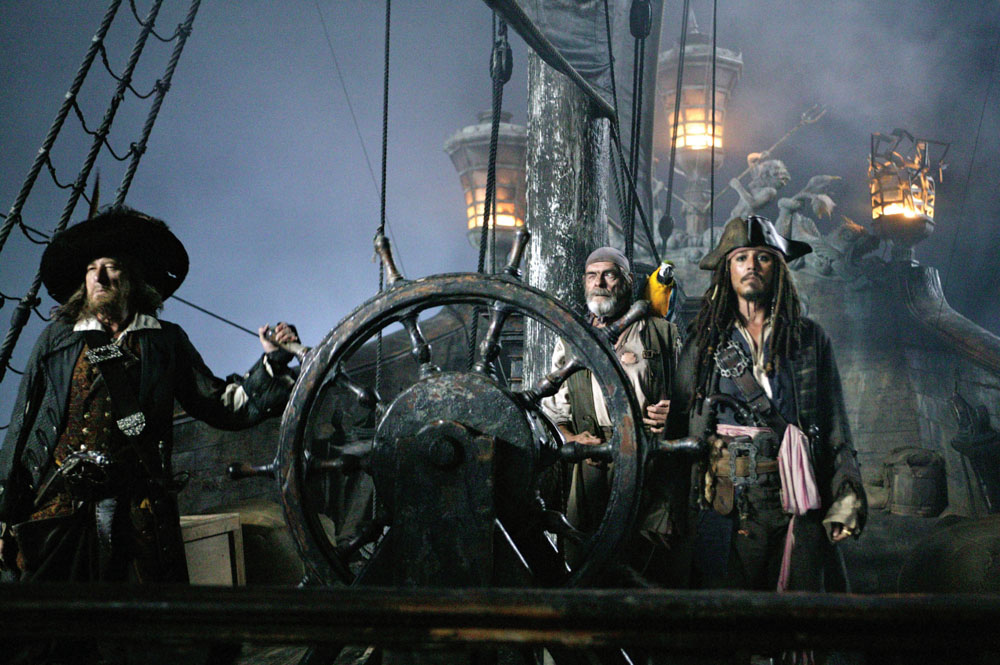
Pirates
of the Caribbean: On Stranger Tides is a 2011 American fantasy swashbuckler film directed by Rob Marshall. It is the first film in the series not to be directed by Gore Verbinski. Produced by Jerry Bruckheimer and written by Ted Elliott and Terry Rossio, the film is suggested by the 1987 novel On Stranger Tides by Tim Powers as a standalone sequel to
At World's End (2007) and the fourth installment in the
Pirates of the Caribbean film series. The film stars Johnny Depp, Geoffrey Rush, and Kevin R. McNally, who reprise their roles from the previous films, alongside Penélope Cruz, Ian McShane, Sam Claflin and Àstrid Bergès-Frisbey. The story follows the eccentric pirate Captain Jack Sparrow (Depp) forced into a shaky alliance with Angelica (Cruz), a mysterious woman from his past, as they embark on a quest for the
Fountain of
Youth. Jack is forced aboard the Queen Anne's Revenge, contends with the infamous pirate Blackbeard (McShane), and enters an uneasy alliance with Jack's rival Hector Barbossa (Rush).
On Stranger Tides was produced by Walt Disney Pictures and Jerry Bruckheimer Films, and distributed by Walt Disney Studios Motion Pictures. During the back-to-back production of
Dead Man's Chest (2006) and At World's End, writers Elliott and Rossio first learned of Powers' novel and considered it a good starting point for a new film in the series. Pre-production started after the end of the 2007–2008 Writers Guild of America strike, with Depp collaborating with the writers on the story design. Principal photography lasted for 106 days between June and November 2010, with locations in Hawaii, the United Kingdom, Puerto Rico and California. Filming employed 3D cameras similar to those used in the production of the 2009 film Avatar, and ten companies were involved with the film's visual effects. Following inflated production costs which ballooned the net budget to $379 million, the film was the most expensive film ever made at the time of its release.
On Stranger Tides was released in the United States on May 20, 2011. The film broke many box office records and was the third highest-grossing film of 2011. A fifth film, titled Dead Men Tell No Tales, was released in May 2017.
PLOT
In 1750, a man rescued from the ocean is brought to King Ferdinand of Spain, where he claims to have sailed with Ponce de León, who died 200 years earlier searching for the Fountain of Youth. Years after Captain Jack Sparrow lost the Black Pearl to Hector Barbossa and acquired Sao Feng's map to find the Fountain, Jack rescues his first mate, Joshamee Gibbs, from execution in London, only to get captured. Gibbs takes Jack's map, while Jack himself is brought before King George II, who wants him to guide an expedition to the Fountain before King Ferdinand's Spanish Armada can locate it. Barbossa, now sporting a peg leg and having lost the Pearl, joins the expedition as a privateer. Jack escapes, leading Barbossa to later recruit Gibbs, who memorizes Jack's map before burning it, and they set sail aboard the HMS Providence.
Captain Teague, Jack's father, tells Sparrow that the Profane Ritual is required to use the Fountain. Jack also hears of another Jack Sparrow recruiting a crew. The impostor is Angelica, Jack's former lover and daughter of Blackbeard, who shanghais Jack into service aboard the Queen Anne's Revenge. Amongst the crew are zombie officers and Philip Swift, a captured missionary. Blackbeard practices voodoo magic as a brujo and wants to find the
Fountain to avoid a prophesied death by a one-legged man. Although Jack incites the human crew to mutiny against the zombies, Blackbeard subdues the mutineers with a sword that allows him to control ships. Jack learns from Angelica that the ritual for the Fountain requires a mermaid's tear and two silver chalices located on Ponce de León's ship, the Santiago. Both chalices get water from the Fountain, and the person who drinks the water with the tear gets all the years of life from the other. Angelica also shows Jack Blackbeard's collection of captured, miniaturized ships in bottles, including the Black Pearl.
The Revenge sails to Whitecap Bay, where Blackbeard's crew captures the mermaid Syrena. Barbossa, Gibbs, and some of the British crew continue on foot after the Providence is attacked by
mermaids. Syrena's tail becomes legs after being out of water; seeing that she cannot walk, Philip offers to carry Syrena. After their newfound love is used to extract the mermaid's tear, Syrena is left to die. Blackbeard sends Jack to get the chalices, taking the latter's magic
compass. Jack and Barbossa meet on the Santiago, but find the chalices have been taken by the Spanish. Before retrieving the chalices, Barbossa reveals his true agenda: a desire for revenge against Blackbeard, detailing the attack on the Black Pearl, which Barbossa truly believes to be sunk, which led to cutting off his leg via self-amputation. Jack returns to Blackbeard, giving him the chalices in exchange for Jack's compass, which Jack sends Gibbs off with.
All parties locate the Fountain of Youth, which leads to a battle, in which Barbossa stabs Blackbeard with a poisoned sword. Angelica cuts her hand on the poisoned blade. The Spanish throw the chalices into a deep pool and destroy the Fountain, believing it as an abomination against God. In the chaos, Philip frees Syrena, who gives the chalices to Jack. Filling the chalices with the remaining drops of water from the Fountain, adding Syrena's tear, Jack tricks
Blackbeard into drinking the chalice lacking the tear. Angelica is healed, whilst Blackbeard dies. Syrena returns to an injured Philip and, after she forgives him, they kiss and return underwater.
Barbossa claims Blackbeard's ship, crew, and sword for his own, and returns to a life of piracy. Meanwhile, Jack maroons Angelica on a cay, unsure if he can trust her. Jack reunites with Gibbs, who uses the compass to locate the Revenge and retrieve the Black Pearl in a bottle. As they figure out how to get the Pearl out, Jack tells Gibbs he's determined to continue living the pirate's life. In a post-credits scene, a voodoo doll of Jack created by Blackbeard washes ashore to Angelica, who smiles.
CAST
- Johnny Depp as Captain Jack Sparrow: Legendary pirate, former captain of the Black
Pearl.
- Penélope Cruz as Angelica: Jack's former love interest, first mate and daughter of Blackbeard. As the production date for On Stranger Tides neared, Penélope Cruz found out she was pregnant with her first child, a son with Javier Bardem. Director Rob Marshall and producer Jerry Bruckheimer worried Cruz might back out, despite Bruckheimer himself saying it didn't affect production, but Cruz remained committed to the film. To accommodate her condition, the schedule was adjusted to shoot more of Cruz's scenes before she started to show. The costume designer created an elastic corset to allow the actress to move more freely, and Cruz's outfits were constantly being altered. "I just had a new fitting every three weeks," Cruz said. "We kept having fittings, but they were very, very kind to do it." Cruz did all of her close-up action scenes, though her pregnancy forced the filmmakers to use a stunt double on more of the wide shots. In September 2010, after it became noticeable on set at Puerto Rico, representatives of Cruz and Bardem confirmed they were four-and-a-half months pregnant. After that, Penélope only filmed Angelica's close-ups while her sister Mónica did all of Angelica's long-distance shots.
- Ian McShane as Blackbeard: Legendary pirate, captain of the Queen Anne's Revenge, and Angelica's father. McShane was previously considered to play Davy Jones (later portrayed by Bill Nighy) in Pirates of the Caribbean: Dead Man's Chest.
- Geoffrey Rush as Captain Hector Barbossa: Legendary pirate-turned-privateer, former captain of the Black Pearl, and Jack's rival.
- Kevin McNally as Joshamee Gibbs: Jack's friend, and former first mate of the Black Pearl.
- Sam Claflin as Philip Swift: A missionary, kept prisoner aboard Blackbeard's ship, and Syrena's love interest.
- Àstrid Bergès-Frisbey as Syrena: A mermaid captured by Blackbeard's crew, and Philip's love interest.
- Stephen Graham as Scrum: A self-serving crew member of the Queen Anne's
Revenge.
- Richard Griffiths as King George II
- Greg Ellis as Lt. Cmdr. Theodore Groves: Barbossa's second-in-command, former second-in-command of Lord Cutler Beckett and Commodore James Norrington's crew.
- Óscar Jaenada as The Spaniard: King Ferdinand's most trusted agent.
- Keith Richards as Captain Teague: Legendary pirate and Jack Sparrow's father.
King George's ministers include Roger Allam as Prime Minister Henry Pelham and Anton Lesser as Lord John Carteret. Damian O'Hare reprises his role as Lieutenant Gillette from the first Pirates movie. Other Spanish characters include Sebastian Armesto as King Ferdinand, Juan Carlos Vellido as a Spanish captain. Judi Dench has a cameo as a society lady who encounters Jack Sparrow in a carriage.
PRODUCTION & DEVELOPMENT
Shortly before the premiere of At World's End, Jerry Bruckheimer stated it was the end of the trilogy, but the idea of a spin-off was still possible. After the film's successful opening weekend, Dick Cook, then Chairman of the Walt Disney Studios, said he was interested in a fourth installment. Los Angeles Times also reported that rights to a book were bought. Johnny Depp was expected to reprise his role as Captain Jack Sparrow. Ted Elliott and Terry Rossio had started working on a script in 2007, but they were interrupted by the 2007–2008 Writers Guild of America strike, and only resumed in mid-2008.
In June 2009, Bruckheimer indicated Disney would prefer the fourth installment of Pirates to be released before The Lone Ranger film, which was being worked on for release in the summer of 2010. He hoped original Pirates director Gore Verbinski would return for the fourth film, as his BioShock film adaptation had been put on hold. As Verbinski was unavailable due to his commitment with Rango the same year, Bruckheimer suggested Rob Marshall, whom he considered a "premiere filmmaker", stating that "Every film [Marshall] made I thought was unique and different." On July 21, 2009, Marshall accepted the job, because of the "whole new story line and set of characters. It felt new, and that was important to me." Marshall's involvement wasn't reported until August. Marshall said the film provided him a long-awaited opportunity to work with Depp, and that his directing was helped by his experience as a choreographer—"the action sequences felt like big production numbers." "I really had one criteria for signing on. And that was a story I could actually follow."
On September 11, 2009, at Disney's D23 convention during a Disney event, Cook and Johnny Depp, in full Captain Jack Sparrow costume, announced that a fourth Pirates film was in development for a summer 2011 release. The title was announced as Pirates of the Caribbean: On Stranger Tides, later revealed to have been taken from Tim Powers's 1987 novel On Stranger Tides. Cook resigned in September 2009 after working for Disney for over 38 years. Depp's faith in Pirates of the Caribbean: On Stranger Tides was somewhat shaken after the resignation, with Depp explaining that "There's a fissure, a crack in my enthusiasm at the moment. It was all born in that office". Depp also explained Cook was one of the few who accepted his portrayal of Jack Sparrow: "When things went a little sideways on the first Pirates movie and others at the studio were less than enthusiastic about my interpretation of the character, Dick was there from the first moment. He trusted me". Regardless, on January 6, 2010, Disney announced that the film would be released on May 20, 2011.
Director Rob Marshall visited the Pirates of the Caribbean ride in Disneyland for inspiration, eventually paying homage with a skeleton holding a magnifying glass in Ponce de León's ship. Another ride reference scene featuring "Old Bill", the pirate who tries to share his rum with a cat, was also filmed but cut. Pintel and Ragetti were originally supposed to make an appearance, but director Rob Marshall opted out of the idea as he feared their roles would be cut.
WRITING
During the production of Dead Man's Chest and At World's End, writers Ted Elliott and Terry Rossio discovered Tim Powers's 1987 novel On Stranger Tides, which they considered a good foundation on which to base "a new chapter" in the Pirates series. Disney bought the rights to the novel in April 2007. In 2009, after the announcement of the film's title, which led to speculation in regards to his book, Powers insisted that Jack Sparrow and his book's main character Jack Shandy "are totally different characters" but that it was possible that "they might overlap" Blackbeard and Barbossa, though felt certain the Fountain of Youth was the only thing they would hold on to due to the film's ending. Rossio stated that he and Elliot had considered using Blackbeard and the Fountain of Youth in the story before reading the book, "but whenever you say those words, Powers's novel comes to mind. There was no way we could work in that field without going into territory Tim had explored." However, they denied that it would be a straight version of the novel: "Blackbeard came from the book, and in the book, there is a daughter character, too. But Jack Sparrow is not in the book, nor is Barbossa. So I wouldn't call this an adaptation."
Rossio declared the script was written to be a standalone film, "kind of a James Bond sort of thing", instead of the "designed to be a trilogy" structure of the previous installments. They hoped to "design a story that would support new characters," knowing that previous arcs were over. Bruckheimer added that there was a decision to "streamline the story a little bit, make it a little simpler and not have as many characters to follow", as the number of characters and subplots in At World's End caused the film to have an unwieldy length. The duo decided to employ another sea myth alluded to in the previous episodes: mermaids, which are briefly referenced as "suck-you-byes, female demons that weirdly and erotically occupied the last hours of men marooned on barren islands" in the fourth chapter of the book. The mermaids' role expanded in the film's script, which included a vast attack sequence.
Depp was deeply involved with the story design, frequently meeting the writers to show what he was interested in doing, and in the words of Rossio, being "involved in coming up with storylines, connecting characters, creating moments that we would then fashion, shape and then go back." Among Depp's suggestions were turning Philip into a missionary and having a Spanish contingent following the protagonists. Afterwards, Rob Marshall and executive producer John DeLuca met Rossio and Elliot and did alterations of their own, including building the female lead.
CASTING
Depp signed on to return as Captain Jack Sparrow in September 2008, saying that he would come back if the script was
good. Almost a year later, Disney announced that Depp would be paid $55.5 million for his role, realizing that without him the franchise would be "dead and buried." Geoffrey Rush expressed interest in returning to his role as Barbossa, and Bruckheimer later confirmed his presence. Rush was positive on Barbossa having lost a leg, as he considered the disability made him "angrier, more forceful and resilient as a character", and had to work with the stunt team for an accurate portrayal of the limp and usage of crutch, particularly during sword fighting scenes.
While the production team considered a prop pegleg to be put over Rush's leg, the tight schedule caused it to be replaced with a blue sock that was replaced digitally, with a knob on the shoe to give Rush a reference for his walk. Three other actors from the previous films returned, Kevin McNally as Joshamee Gibbs, Greg Ellis as Lt. Theodore Groves, and Damian O'Hare as Lt. Gilette. Keith Richards also had a cameo, reprising his role as Captain Teague from At World's End; he and Depp tried to persuade Mick Jagger to audition for the part of a pirate elder. Previous cast members Orlando Bloom (Will Turner) and Keira Knightley (Elizabeth Swann) stated that they would not reprise their roles, as they wanted to be involved in different films. They both thought the storyline involving their characters had gone as far as it could. On August 1, 2009, Bill Nighy expressed his desire to return as Davy Jones, who died in the previous film, citing a possibility to resurrect the character, but at the end, his inclusion was scrapped. On February 5, 2010, Mackenzie Crook also announced he would not be reprising his role of Ragetti, stating, "They haven't asked me. But actually I don't mind that at all. I'm a fan of the first one especially and I think the trilogy we've made is great. I'd almost like them to leave it there."
New cast members include Ian McShane, who plays the notorious pirate and primary antagonist of the film, Blackbeard, and Penélope Cruz, who plays Angelica, Jack Sparrow's love interest. According to Marshall, McShane was chosen because "he can play something evil but there's always humor behind it as well" and the actor accepted the job due to both the "very funny and charming" script and the opportunity to work with Marshall. The beard took one hour and a half to get applied, and McShane likened the character's costume to "a real biker
pirate - it's all black leather.” Marshall said Cruz was the only actress considered for the role, as she fit the description as "an actress who could not only go toe to toe with Johnny and match him, but also needed to be all the things that Jack Sparrow is in a way. She needed to be funny and clever and smart and crafty and beautiful", and invited her for the role as they wrapped the production of Nine.
The actress spent two months working out and learning fencing for the role. Cruz was pregnant during filming, leading the costume department to redesign her wardrobe to be more elastic and the producers to hire her sister Mónica Cruz to double for Penélope in risky scenes. Depp recommended Stephen Graham, who worked with him in Public Enemies, to play Scrum, a Machiavellian pirate and sidekick to Jack Sparrow, and Richard Griffiths for the role of King George II, as Depp was a fan of Griffiths' work on Withnail and I. Sam Claflin, a recent drama school graduate with television experience, was chosen to play the missionary Philip, and British actor Paul Bazely also joined the cast. Spanish news website El Pais reported that the film had four Spanish actors: Cruz, Àstrid Bergès-Frisbey, Óscar Jaenada, and Juan Carlos Vellido. Jaenada was picked for both his work in The Losers and a recommendation by Cruz.
Casting for mermaids required the actresses to have natural breasts—no implants. As Bruckheimer explained to EW, "I don't think they had breast augmentation in the 1700s, [...] So it's natural for casting people to say, 'We want real people.'" Marshall invited Spanish-French actress Àstrid Bergès-Frisbey to play Syrena after seeing her in a French magazine article on up-and-coming actresses. Bergès-Frisbey had to take lessons of English, swimming and breath control for the role. The rest of the mermaid portrayers, such as Australian supermodel Gemma Ward, were chosen for having "exotic sense, an otherworldly sensibility, but also under those layers a deadly quality", according to Marshall, and had to take swimming lessons to learn movements such as the dolphin and eggbeater kicks.
FILMING
Principal photography began on June 14, 2010, in Hawaii. Filming was moved to California in August 2010, primarily at the Long Beach shore and a recreation of Whitecap Bay done in the Universal Studios backlot, as the original Hawaiian location on Halona Cove was plagued with strong tides. After a brief shoot in Puerto Rico, with locations in both Palomino Island and the Fort of San Cristóbal in San Juan, production moved to the United Kingdom in September, where principal photography wrapped on November 18 after 106 days of shooting Locations included Hampton Court Palace in London, Knole House in Kent, and Old Royal Naval College at Greenwich. Interiors were shot at London's Pinewood Studios, and a replica of an 18th-century London street was built on the backlot alongside the soundstages. The producers also considered using New Orleans as a location. In October, security was breached at the UK site when a celebrity impersonator gained access to filming at the Old Royal Naval College by dressing up as Captain Jack.
After the joint production of Dead Man's Chest and At World's End cost over $300 million, Disney decided to give a lower budget to the fourth installment. Many costs had to be cut, including moving primary production to Hawaii and London, where tax credits are more favorable, and having a shorter shooting schedule and fewer scenes featuring special effects compared to At World's End. The tighter
schedule - according to Bruckheimer, "We had a 22-week post, and for a picture like this, with almost 1,200 visual effects shots, it's usually 40
weeks" - meant that Marshall supervised editing of sequences during filming. The British financial statements of the film revealed total expenditures of £240.7 million ($410.6 million) by 2013, with Disney receiving a rebate of $32.1 million from the British government, making Pirates of the Caribbean: On Stranger Tides the most expensive film ever made to date.
Bruckheimer said the decision to film in 3D was made due to its being "immersive filmmaking; I think it makes you part of the actual filming because you're part of the screen." Bruckheimer described it as the first major "exterior movie" to be shot in 3D, as Avatar was mostly done in sound stages. At first Marshall was not much interested in 3D, but the director eventually considered it a film that could benefit from the format. "You are on an adventure and with the 3D experience you are inside that adventure." While the original plan was to add 3D effects during post-production, the decision was made to shoot digitally with 3D cameras. Only one sequence was shot conventionally and needed a 3D conversion. The cameras were improved versions of the ones James Cameron developed for Avatar, which were made more compact for extra mobility. This meant the cameras could be brought into locations such as the Hawaiian jungle.
Queen Anne's Revenge was built atop Sunset, the same ship used to depict Black Pearl in previous installments. In February 2010, Sunset was sailed from Long Beach to a shipyard in Hawaii for the reforms, where a big concern was to make it imposing, with three stories, without sacrificing actual seakeeping. Given Blackbeard was meant to be the meanest pirate to appear in the series, the look for Queen Anne's Revenge was ominous, with sails dyed blood red, various elements on fire, and a decoration based on skulls and bones (drawing inspiration from the Sedlec Ossuary in Czech Republic). Damage from cannon fire was also added to show that "not only Blackbeard was a dying man, but his ship is also a dying ship". The ship's figurehead also drew inspiration from Blackbeard's pirate flag. The replica ship HMS Surprise was used for Barbossa's ship, HMS Providence, and all the scenes aboard Providence were shot on the Long Beach shore as Surprise could not be sailed to Hawaii. Over 50 designs were considered for the Fountain of Youth, with the final one representing a temple built by an ancient civilization around the Fountain, which itself was located in a round rocky structure to represent "the circle of life". The locations leading up to the Fountain were shot in the Hawaiian islands of Kauai and Oahu, but the Fountain itself was built at the 007 Stage on Pinewood.
CRITICS & BOX OFFICE
On Stranger Tides earned $241.1 million in North America and $804.6 million in other countries for a worldwide total of $1.045 billion. It is the third-highest-grossing film of 2011 and the second most successful installment of the Pirates of the Caribbean series. On its worldwide opening weekend, it grossed $350.6 million, surpassing At World's End's $344 million opening as best in the series and ranking as the seventh-highest worldwide opening. It scored an IMAX worldwide opening-weekend record with $16.7 million (first surpassed by Transformers: Dark of the Moon).
It set records for the least time to reach $500, $600, and $700 million worldwide (in 10, 12 and 16 days, respectively). The first of these records was first surpassed by Dark of the Moon and the other two by Harry Potter and the Deathly Hallows – Part 2. After 46 days in theaters (July 2, 2011), it became the eighth film in cinema history and the fourth film released by Walt Disney Studios to cross the $1-billion-mark. It set a record for the fastest Disney-distributed film to reach the milestone (first surpassed by Marvel's The Avengers) and it is the fifth-fastest film overall to achieve this.
During its Thursday-midnight showings, On Stranger Tides earned $4.7 million from 2,210 theaters, and $34.9 million in total on its opening day. It earned $90.2 million on its opening weekend, topping the weekend box office, but earning much less than its two immediate predecessors (At World's End – $114.7 million and Dead Man's Chest – $135.6 million) and the directly preceding Johnny Depp spectacle (Alice in Wonderland – $116.1 million). 3D showings accounted for only 46% of its opening-weekend gross. It closed on September 29, 2011, with a $241.1 million gross, ranking as the fifth-highest-grossing film of
2011 and the least profitable film of the franchise. However, it was the top-grossing movie during May 2011 (with $166.8 million by May 31).
Outside North America, On Stranger Tides is the sixth-highest-grossing film, the third-highest-grossing Disney film, the third-highest-grossing 2011 film and the highest-grossing film of the Pirates of the Caribbean series. It is the highest-grossing Pirates film in at least 58 territories.
During its opening day (Wednesday, May 18, 2011), On Stranger Tides made $18.5 million from 10 territories. It added 37 territories and $25.7 million on Thursday, for a two-day total of $44.2 million, and on Friday, it expanded to almost all countries, earning $46.2 million for a three-day total of $92.1 million. On its five-day opening weekend as a whole, it earned a then-record $260.4 million from 18,210 screens in more than 100 territories, in all which it reached first place at the box office. The record debut was surpassed later in the same summer season by Deathly Hallows Part 2. Earnings originating from 3-D showings accounted for 66% of the weekend gross, which was a much greater share than in North America. Its highest-grossing countries during its first weekend were Russia and the CIS ($31.42 million including previews), China ($22.3 million) and Germany ($20.53 million). It dominated for three weekends at the overseas box office despite competition from The Hangover Part II, Kung Fu Panda 2, and X-Men: First Class. It reached the $300, $400 and $500-million-mark at the box office outside North America in record time (7, 11 and 14 days respectively), records first surpassed by Deathly Hallows – Part 2.
On Stranger Tides set opening day records in both Russia (including the CIS) and Sweden. Subsequently, it set opening-weekend records in Latin America, the Middle East, Russia, Norway, Ukraine and Turkey, still retaining the record in Russia ($26.8 million) and Ukraine ($2.15 million). Its highest-grossing market after North America is Japan ($108.9 million), followed by China ($71.8 million) and Russia and the CIS ($63.7 million). It is the highest-grossing film of 2011 in Russia and the CIS, Austria, Ukraine, Greece, Portugal and Angola, South Africa, Romania, Bulgaria, Egypt, Estonia, and Latvia.
On the review aggregator website Rotten Tomatoes, 33% of 278 critics' reviews are positive, with an average rating of 5/10. The website's consensus reads: "It's shorter and leaner than the previous sequel, but this Pirates runs aground on a disjointed plot and a non-stop barrage of noisy action sequences." Metacritic, which uses a weighted average, assigned the film a score of 45 out of 100, based on 39 critics, indicating "mixed or average" reviews. CinemaScore polls reported that the average grade moviegoers gave the film was a "B+" on an A+ to F scale.
Roger Ebert gave On Stranger Tides two out of four stars, saying that although the removal of Knightley and Bloom as well as the addition of Cruz were positive aspects, the film in general was "too much of a muchness" for him. Tom Long of The Detroit News gave a D+, saying that Jack Sparrow had "worn out his welcome". Despite the more linear plot, "the movie is still ridiculous". He found On Stranger Tides to be "precisely what you'd expect of the fourth installment of a movie based on an amusement park ride: a whole lot of noise, plenty of stunts and complete silliness." British film critic Mark Kermode gave the film an overwhelmingly negative review on his 5 Live show, saying "it's not as staggeringly misjudged as the third part, because it is just nothing, it is just a big empty nothing, whereas part three I think was an active atrocity, it's just nothing at all".
As with the previous films, the plot was criticized as incoherent and confusing. The Arizona Republic critic Bill Goodykoontz rated the film two out of five, stating that "the movie is a series of distractions tossed together in the hopes that they will come together in a coherent story. That never really happens." Online reviewer James Berardinelli considered the script "little more than a clothesline from which to dangle all of the obligatory set pieces", and USA Today's Claudia Puig found On Stranger Tides "familiar and predictable...often incoherent and crammed with pointless details."
Mike Scott from The Times-Picayune mentions that "while this latest chapter isn't quite sharp enough to restore the sense of discovery that made that first outing so darn exciting, it's enough to make up for most of the missteps that made the third one so darn arrgh-inducing." Writing for The A.V. Club, Tasha Robinson described On Stranger Tides as "a smaller film than past installments, by design and necessity", and felt that "the series has needed this streamlining" as the film "feels lightweight, but that's still better than bloated."
On Stranger Tides also had positive reviews; some critics found the film to be entertaining and well-made. Richard Roeper gave the film a B+, describing it as "the most fun installment since the first", calling the story "pure cartoon, but a lot easier to follow than the other sequels", and summing as "the franchise is getting tired, but Penelope energizes it." Along the same lines, Ann Hornaday of The Washington Post gave the film three out of four stars, writing that it "feels as fresh and bracingly exhilarating as the day Jack Sparrow first swashed his buckle, infusing new reckless energy into a franchise that shows no signs of furling its sails". She said that Marshall "swiftly and without fuss delivers the action set pieces and eye-popping escapism" and praised Depp, Cruz, and McShane's performances. Ray Bennett from The Hollywood Reporter considered that Marshall "shows terrific flair with all the usual chases and sword fights, and he handles the 3D well", and welcomed Penélope Cruz's character, saying she "brings her Oscar-winning vivacity" and had "lively sexual tension" with Depp. Writing for The Globe and Mail, Rick Groen found the action scenes to range from "merely competent to tritely cluttered", but he was pleased with the overall result, calling McShane a "fresh villain" whose "stentorian tones are welcome anywhere". Variety's Andrew Barker considered the film derivative, but accessible. "It has nary an original idea and still doesn't make much sense, but it's lost all pretensions that it should". He praised Geoffrey Rush, stating that he "not only gets the funniest lines and reaction shots, but also starts to siphon away much of the roguish charm that used to be Depp's stock and trade."
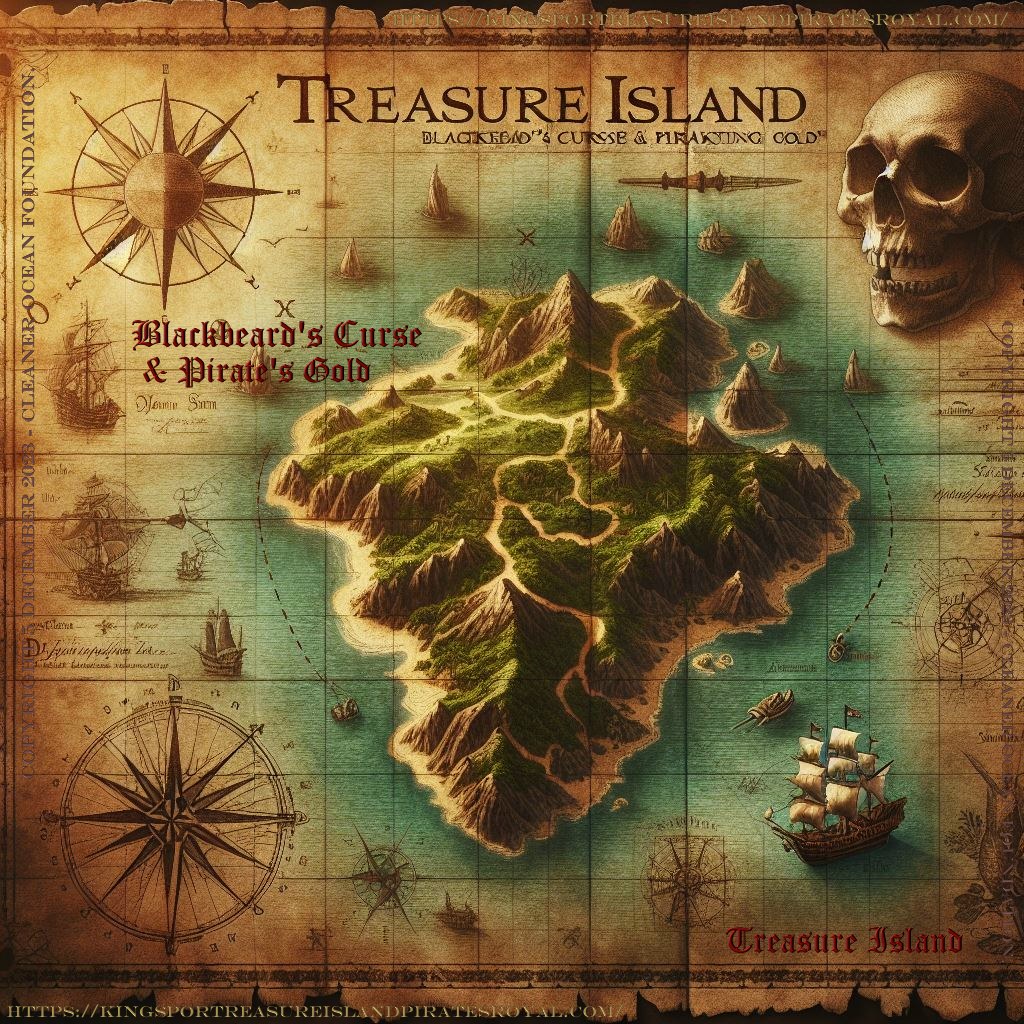
PIRATES
OF TORTUGA
Disney
made an excellent series of fantasy swashbuckler films based on the legendary haunt, Tortuga,
and piracy, a formula that made Errol Flynn famous as a privateer for Good
Queen Bess, romanticizing the plundering and treasure hunting, with
British Naval officers as some of the antagonists.
The series is intermingled with ghost ships and pirates, that are
cursed, relying heavily on CGI for effects - that are excellent in the
main, if a little overdone on the skeletal ghost front. A little goes a
long way!
The
key players of the Pirates of the Caribbean film
series are Johhny Depp as Captain Jack Sparrow,
Elizabeth Swann (Keira
Knightly)
and Geoffrey Rush as
Captain Hector Barbossa, with Orlando
Bloom as Will Turner.
Pirates
of the Caribbean was produced by Jerry
Bruckheimer and based on Walt Disney's theme park attraction of the
same name. The film series serves as a major component of the eponymous
media franchise.
Directors of the series include Gore
Verbinski (films 1–3), Rob Marshall (4),
Joachim Rønning (5–6),
and Espen Sandberg (5). The series is primarily written by
Ted Elliott
and Terry Rossio (1–4); other writers include Stuart Beattie (1), Jay Wolpert (1), Jeff Nathanson (5), Craig Mazin (6).
The stories follow the adventures of
Captain Jack Sparrow (Johnny Depp), Will Turner
(Orlando Bloom) and Elizabeth Swann (Keira Knightley). Characters such as Hector Barbossa (Geoffrey Rush) and Joshamee Gibbs
(Kevin McNally) follow Jack, Will and Elizabeth in the course of the films.
The fourth film features Blackbeard
(Ian McShane) and Angelica (Penélope
Cruz), while the fifth film features Armando Salazar (Javier
Bardem), Henry Turner (Brenton
Thwaites) and Carina Smyth (Kaya
Scodelario).
The films take place in a fictionalized historical setting; a world ruled by the
British
Empire, the East India Trading Company (based on the real East India Trading Company) and the Spanish Empire, with pirates representing freedom from the ruling powers.
The film series started in 2003 with Pirates of the Caribbean: The Curse of the Black Pearl, which received positive reviews from critics and grossed US$654 million worldwide.
After the first film's success,
Walt Disney Pictures revealed that a film series was in the works. The franchise's second film, subtitled Dead Man's Chest, was released three years later in 2006; the sequel proved successful, breaking financial records worldwide the day of its premiere.
Dead Man's Chest ended up being the number one film of the year upon earning almost $1.1 billion at the worldwide box office.
The third film in the series, subtitled At World's End, followed in 2007 earning $960 million, and Disney released a fourth film, subtitled On Stranger Tides, in 2011 in conventional 2D, Digital 3-D and IMAX 3D. On Stranger Tides succeeded in also grossing more than $1 billion, becoming the second film in the franchise and only the eighth film in history to achieve this.
The franchise has grossed over $4.5 billion worldwide; it is the 14th-highest-grossing film series of all time, and is the first film franchise to produce two or more movies that grossed over
$1
billion.
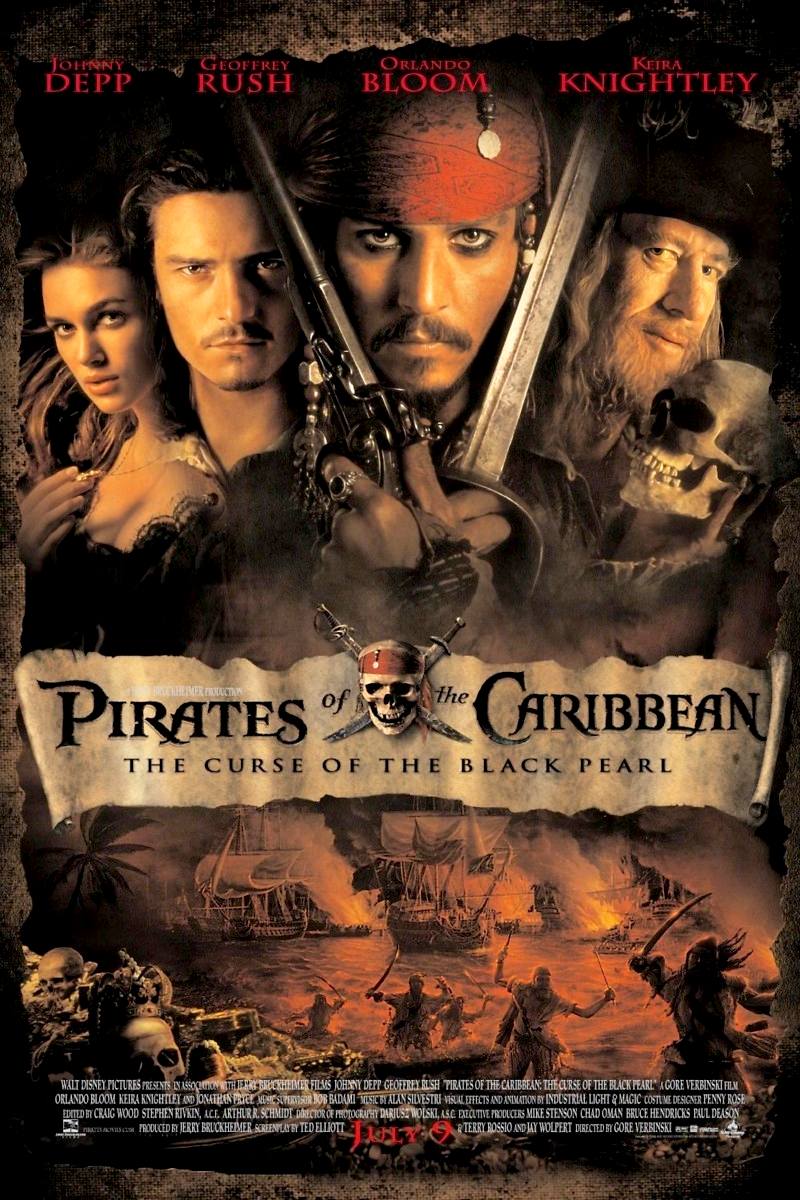
1. Pirates of the Caribbean: The Curse of the Black Pearl (2003)
Blacksmith Will Turner teams up with eccentric pirate Captain Jack Sparrow to save Turner's love, Elizabeth Swann, from cursed pirates led by Jack's mutinous former first mate, Hector Barbossa. Jack wants revenge against Barbossa, who left him stranded on an island before stealing his ship, the Black Pearl, along with 882 pieces of cursed Aztec Gold.
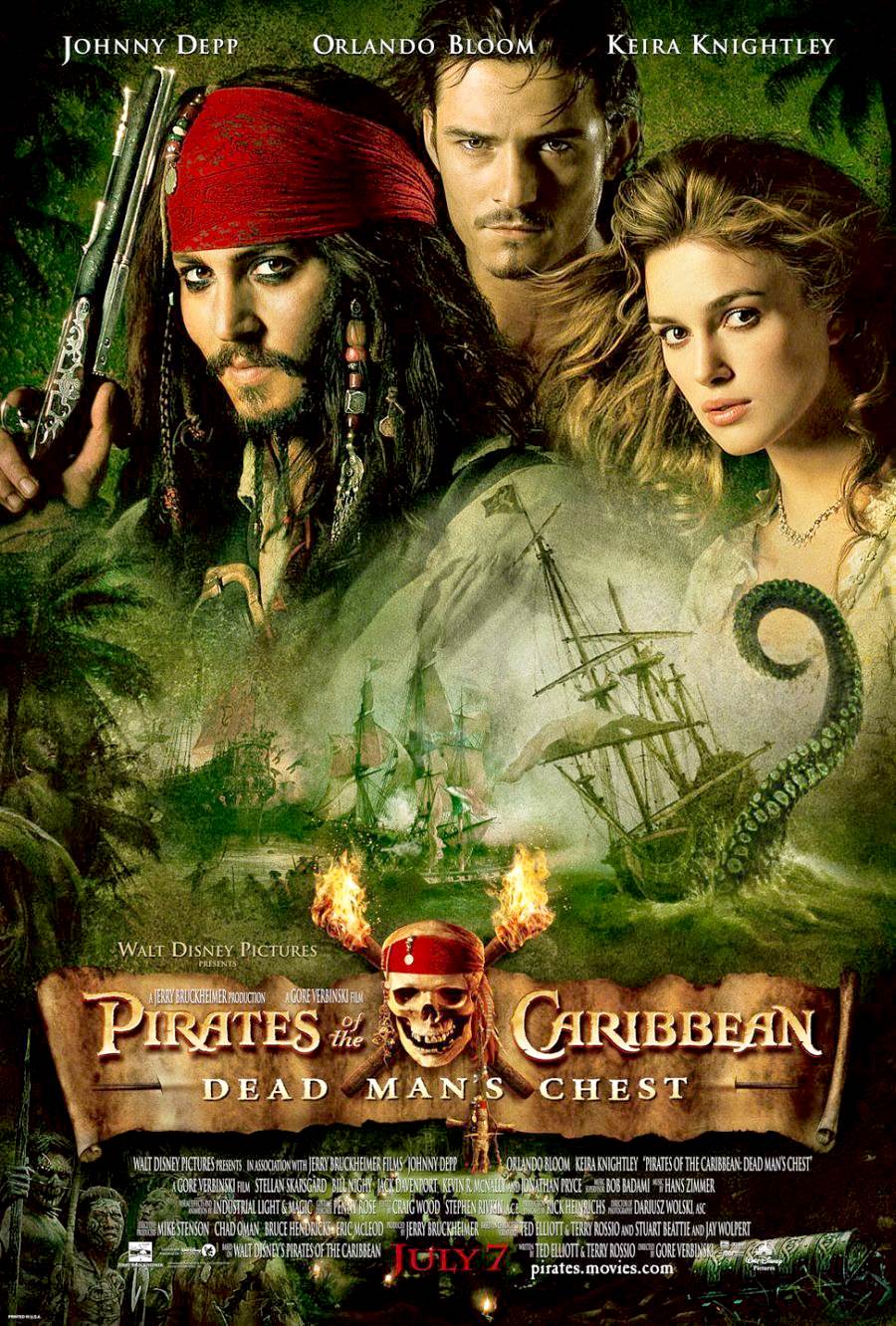
2. Pirates of the Caribbean: Dead Man's Chest (2006)
Lord Cutler Beckett of the East India Trading Company arrests Will and Elizabeth for aiding Captain Jack Sparrow in the previous film. Beckett offers clemency if Will agrees to search for Jack's
compass in a bid to find the Dead Man's Chest
- and inside, the heart of villainous Davy Jones - which would give Beckett control of the seas. However, Jack wants the Chest to escape from an unpaid debt with Jones, who made Jack captain of
the Black Pearl for 13 years in exchange for 100 years of service aboard Jones' ship,
the Flying Dutchman.
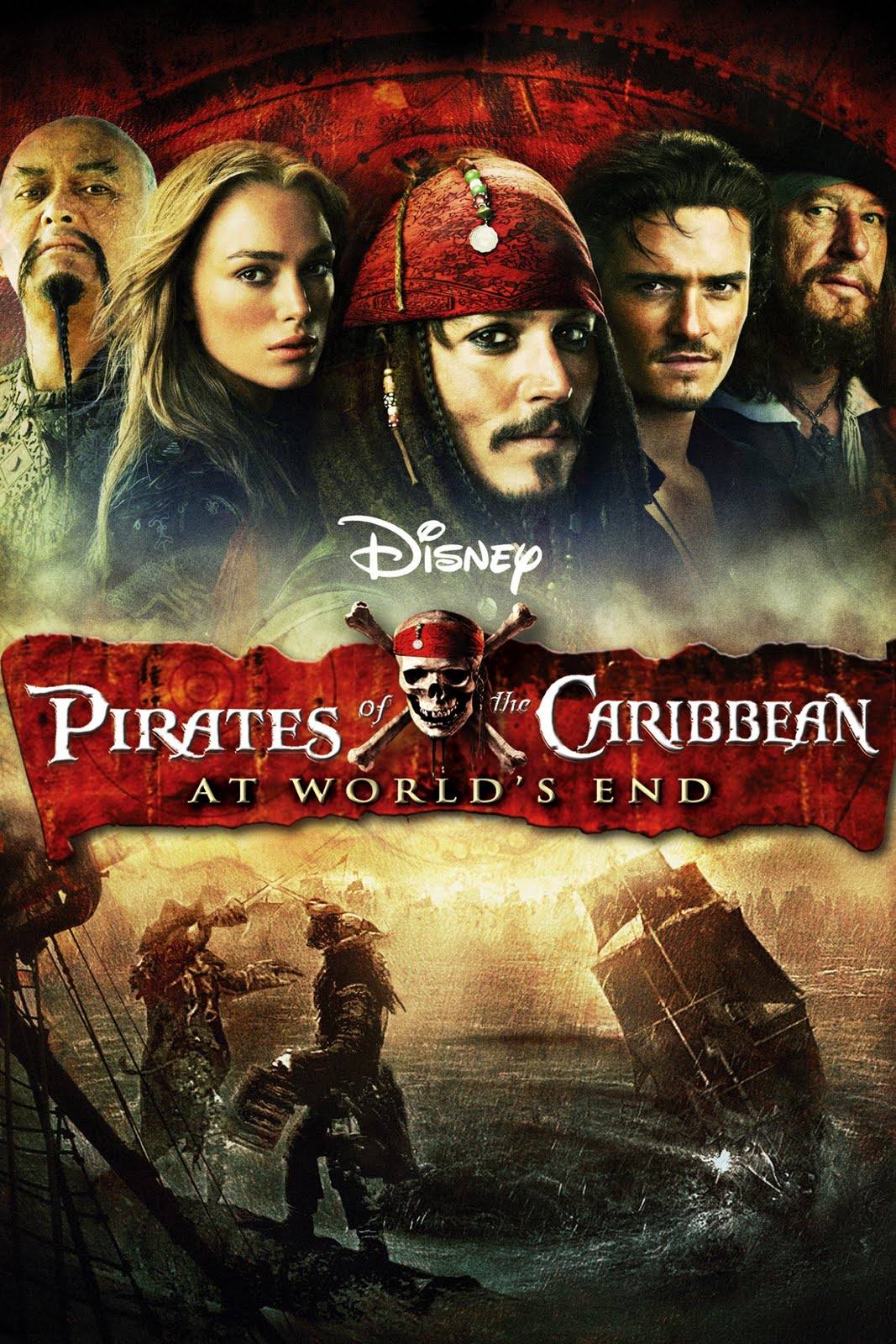
3. Pirates of the Caribbean: At World's End (2007)
Lord Beckett gains power over Davy Jones and, with the help of the Flying
Dutchman, he is now executing his plans to extinguish piracy forever. To stand against the East India Trading Co., Will, Elizabeth, Barbossa, and the crew of the Black Pearl set out to rescue Captain Jack Sparrow from Davy Jones' Locker. As one of the Nine Pirate Lords, Jack is needed in order to release an ancient goddess with the power to defeat Beckett's forces.
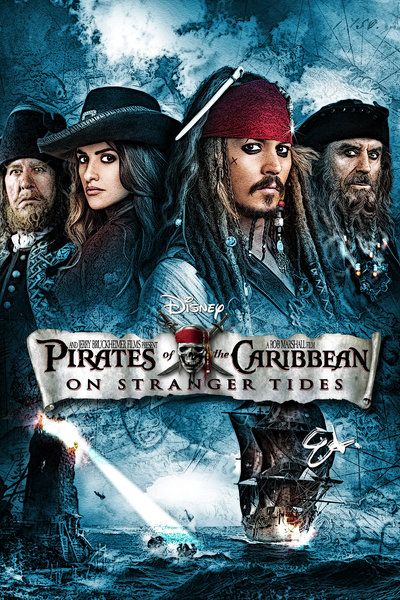
4. Pirates of the Caribbean: On Stranger Tides (2011)
Captain Jack Sparrow is on a quest to find the fabled Fountain of Youth and crosses paths with a former lover, Angelica. She forces Jack aboard the
Queen Anne's
Revenge, a ship captained by the infamous pirate Blackbeard, Angelica's father. Both are also in search of the Fountain: Angelica to save her father's soul, Blackbeard to escape a prophecy of his demise at the hands of a one-legged man. Joining the hunt is former pirate captain Barbossa, now a privateer in King George II's Navy, who is in a race against the Spanish for the Fountain of Youth.
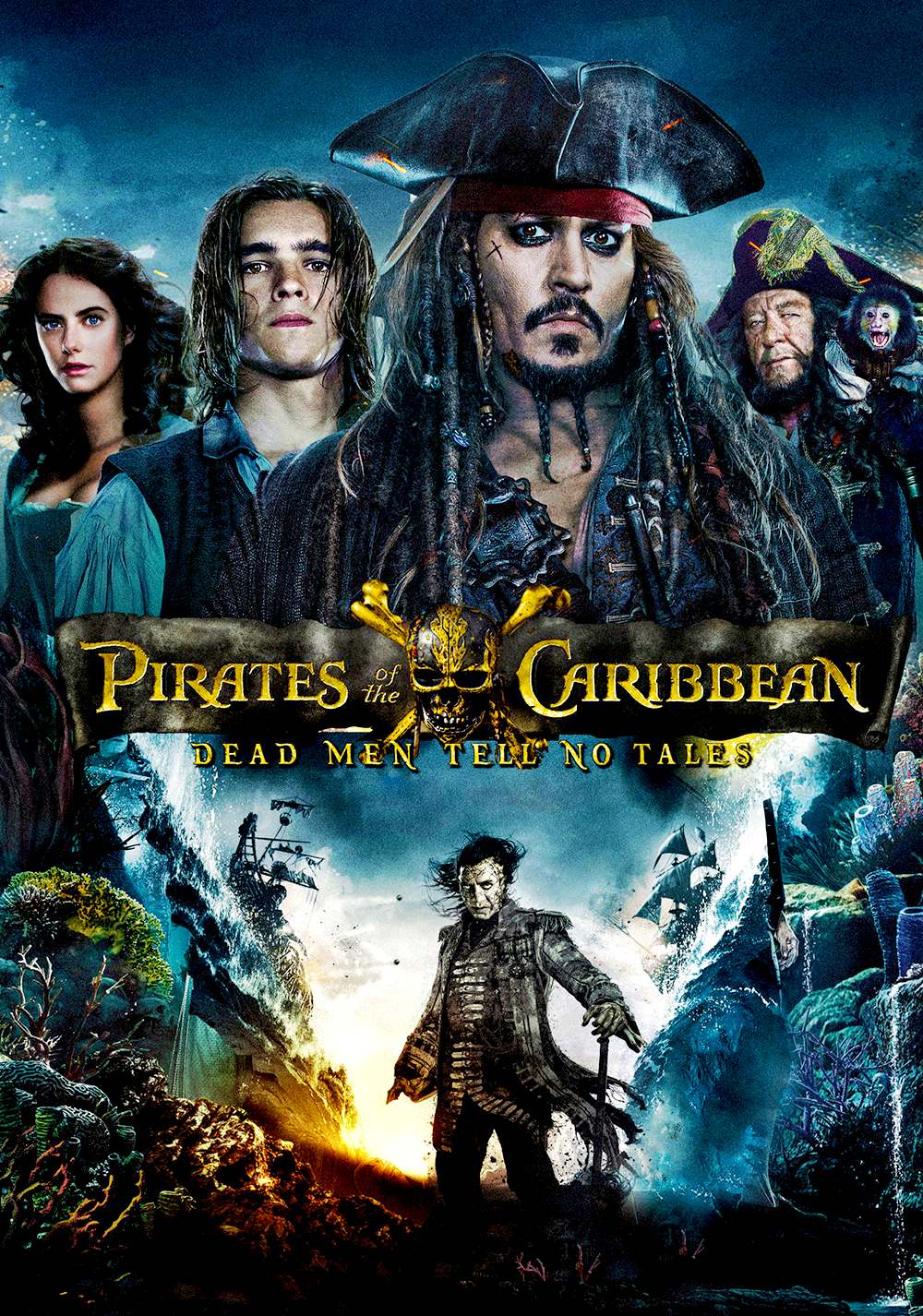
5. Pirates of the Caribbean:
Dead Men Tell No Tales (2017)
A group of ghostly Spanish Royal Navy soldiers led by Jack Sparrow's old nemesis, Captain Armando Salazar, escape from the Devil's Triangle, with the goal of killing every pirate at sea, including Sparrow. To survive, Sparrow seeks out the legendary Trident of Poseidon, a powerful artifact whose owner can control the seas, tides, aquatic animals and break curses.
6. Potential Sixth film
Shortly before the release of On Stranger Tides, it was reported that Disney was planning to shoot the fifth and the sixth films back-to-back, although ultimately only the fifth installment was developed. By March 2017, director Joachim Rønning stated that Dead Men was only the beginning of the final adventure, confirming that it would not be the last film of the series. In September 2017, producer Jerry Bruckheimer indicated that another Pirates of the Caribbean is still in development. In October of the same year, Kaya Scodelario stated that she is contractually signed to return for a sixth film. Shortly after, it was confirmed that Rønning will direct the film. In May 2020, there were reports that the studio were considering Karen Gillan, Daisy Ridley and Emma Watson for the female lead, while Bruckheimer commented that the first draft of the screenplay for the sixth film would soon be finished, adding that he was "unsure" of Depp's role in the movie.
7. Potential Spin-off film
In June 2020, it was announced that Disney was developing a female-led spin-off with Christina Hodson set to pen the screenplay and Margot Robbie attached to star. The film will be a separate from the sixth film currently being developed. Jerry Bruckheimer will also be attached to the project as producer.
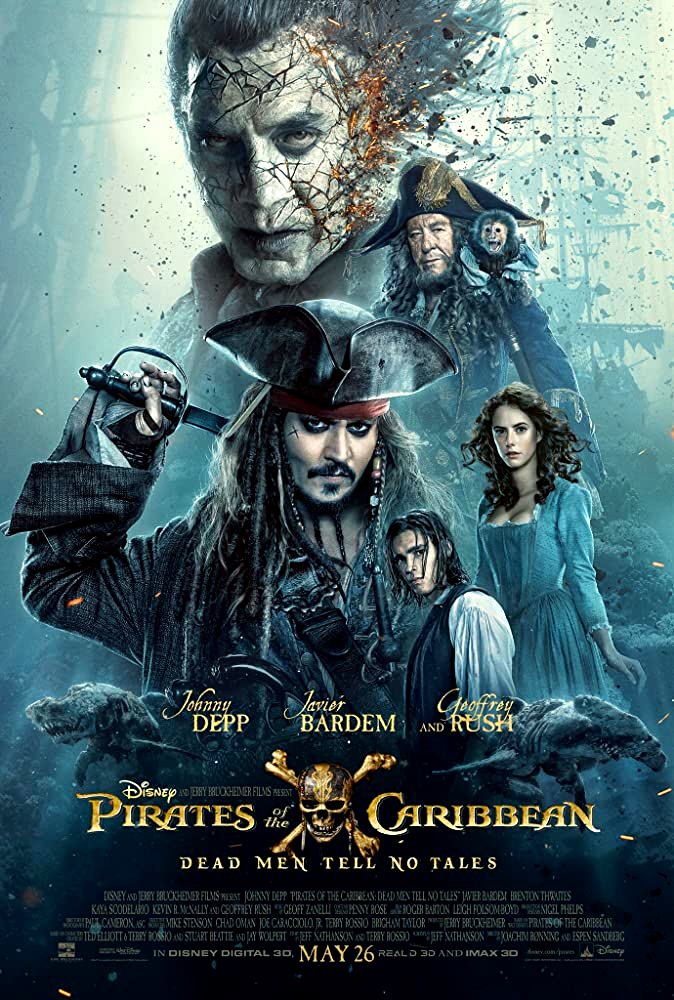
BOX OFFICE
1. The Curse of the Black Pearl July 9, 2003 $654,264,015 - Budget: $140 million
2. Dead Man's Chest July 7, 2006 $1,066,179,725 - Budget: $225 million
3.
At World's End May 25, 2007 $963,420,425 - Budget: $300 million
4.
On Stranger Tides May 20, 2011 $1,045,713,802 - Budget: $378.5 million
5.
Dead Men Tell No Tales May 26, 2017 $794,780,215 - Budget: $230 million
Total
Revenue: $4,524,358,182 - Budget $1.274 billion
Not
bad!
A
BIT OF PIRATE HISTORY
Pirates have existed since ancient times – they threatened the trading routes of ancient Greece, and seized cargoes of grain and olive oil from Roman ships. The most far-reaching pirates in early medieval Europe were the Vikings.
A life of Piracy on the high seas tempted poor seamen because it offered them the chance to take more control of their
lives and adventure. Ordinary seamen toiled for modest wages and were subject to strict discipline. In contrast, piracy offered sailors a chance to get rich quick as
equals or at least shareholders of captured booty.
ENGLISH SEA DOGS, PRIVATEERS
English Sea Dogs were pirates that sailed during the Privateering Era under the leadership of
Queen Elizabeth I between 1560 and 1605. During this time they had explicit permission from the Queen known as a Letter of Marque which allowed them to engage in acts of piracy against the Spanish and other colonial powers the English were at war with at the time.
One of the first well known English Sea Dogs would be John Hawkins who began in the mid 16th century. Hawkins would also be engaged in the slave trade as part of the Trans-Atlantic Triangular Trade. Another famous Sea Dog was
Francis Drake who raided Spanish settlements all across the world. One of Drakes most famous exploits was to sail around to the Pacific Coast and raid Spanish settlements before returning to England, completing his second
circumnavigation of the globe.
In 1588 the famous English Sea Dogs named Francis Drake, John
Hawkins, Walter Raleigh and Martin Frobisher were all part of the English naval forces that helped defeat the Spanish Armada and challenge Spanish naval
dominance. In 1604 when peace was made with Spain many of the Sea Dogs went to work in the Barbary States.
Overall the English Sea Dogs were responsible for striking great blows against the Spanish Main. Eventually they would be replaced by the English Buccaneers who operated throughout the Buccaneering Era and helped manage to establish actual colonies for the British Empire throughout the West Indies.
CORSAIRS
Corsairs were pirates who operated in the Mediterranean Sea between the 15th and 18th centuries. Muslim corsairs, such as the Barbarossa (red beard) brothers, had bases along North Africa’s Barbary Coast, while Christian corsairs were based on the island of Malta. Both used to swoop down on their targets in oar-powered boats called galleys, to carry off sailors and passengers. Unless these unfortunates were rich enough to pay a ransom, they were sold as slaves.
BUCCANEERS
Thousands of pirates were active between 1650 and 1720, and these years are sometimes known as the 'Golden Age’ of piracy. Famous pirates from this period include
Henry
Morgan, William 'Captain' Kidd, 'Calico' Jack Rackham, Bartholomew Roberts and the fearsome Blackbeard (Edward Teach).
By the beginning of the 18th century, piracy was becoming hard work. The Spanish galleons no longer plied the oceans with chests full of dubloons, and responsible governments with large navies were getting tired of pirates preying on their vessels.
Still, there was a living to be made by those who were prepared to take
risks. The famous pirate Blackbeard (Edward Teach) plundered successfully for nearly three years until, in a hand-to-hand fight with Lieutenant Maynard of the H.M.S. Pearl, he
was taught the difference between swinging a cutlass brutally and skill and
training with a blade. Twenty-five wounds later, Blackbeard expired on the deck.
In 1717, George I offered a general amnesty to all pirates who surrendered themselves before 5th September of the following year. Many members of the profession
decided to quit while ahead and settled down to become respectable citizens. There were a few
pirates who could not change their lives of piratical adventure. They were hunted down ruthlessly
until by 1725 it was just about over.
FRENCH
BUCCANEERS
French buccaneers were famous pirates of the Buccaneering Era that were from the French Empire. These buccaneers were responsible for establishing the first French colony in the New World in Spanish controlled La Florida that was known as Saint Caroline. However, this settlement of French huguenots was wiped out by the Spanish under the command of Pedro Menendez de Aviles who assaulted them from nearby Saint Augustine.
After this defeat the French buccaneers moved to the rocky outcrop island of Tortuga off the coast of Hispaniola and established
the famous pirate haven. They would clash with the Spanish for many decades and eventually be successful in not only claiming Tortuga but
a third of the island of Hispaniola as well that the French named Saint-Dominigue.
French buccaneers were just as famous as their English or Dutch counterparts.
Buccaneers lived on the Caribbean island of Hispaniola and its tiny turtle-shaped neighbour, Tortuga, in the 17th century. At first they lived as hunters, but later the governors of Caribbean islands paid the buccaneers to attack Spanish treasure ships. Although raids began in this way, with official backing, the buccaneers gradually became out of control, attacking any ship they thought carried valuable cargo, whether it belonged to an enemy country or not. The buccaneers had become true pirates.
Privateers, meanwhile, were privately owned (rather than navy) ships armed with guns, operating in times of war.
17th century pirates were also known as buccaneers and operating mostly during the Buccaneering Era. Called boucaniers, the English term 'buccaneers', these groups of French and English pirates would raid Spanish settlements and ships alike in a state sponsored piracy campaign.
The buccaneers of the 17th century were generally more ruthless, and merciless than the 18th century pirates.
Operating out of their bases at Port Royal and Tortuga, the 'Brethren of the Coast' were not pirates in the sense they were conquerors. Buccaneers raided ships at sea when it was convenient for them but they also had massive armies with which they would militarily take out Spanish troops and invade settlements from the land. They were known for sacking and ransoming cities,
but there total take was a lot less than the 18th century pirates in that they had more men to split the loot with.
Most of the exploits of the buccaneers are only known about through the
writings of the surgeon aboard Henry Morgan's ship named Alexander Exquemelin. His primary source book first published in Dutch as De Americaensche Zee Roovers (1678),
known in English as the 'Buccaneers of America,' is one of the best documents
to understand the biographical story of the buccaneers.
Maties, please use our A-Z to
navigate this site or return HOME
me
hearties.






